6 ways to deliver exceptional customer service: A guide

Customer Support Manager - Tier 1

Tags
Share
You don’t have to work at Starbucks or the Ritz-Carlton to be known for exceptional customer service experiences.
But even the most well-known companies have had bad customer service stories that are a quick Google search away.
Today, whether you’re a business owner or a contact center agent, you likely have a direct hand in providing a good customer experience. And managing our Tier 1 Customer Support team, I’ve seen firsthand how exceptional customer service can help a business improve retention, get more valuable customer feedback, and even drive word-of-mouth referrals.
First, let’s look at what “exceptional customer service” looks like.
What does exceptional customer service look like?
Exceptional customer service isn’t just about helping your customers solve problems or “meeting customer expectations.”
It’s proactive, efficient, and should make your customers go, “Wow” after an interaction with you. Here are some essential traits that you’ll see in a customer experience team that’s hitting customer service objectives and providing an exceptional level of service.
Competent
Your customer service team can be as friendly and nice as you want, but if they’re not competent, then you just can’t provide great customer service. Bottom line: When a customer contacts your support team, they expect their needs to be understood and that you’ll be able to successfully guide them to a solution.
In my experience, the bare minimum here isn’t just adequate technical knowledge—it also includes things like communication skills (written and verbal). Think of the last exceptional customer service you’ve experienced when you contacted a company. Likely, the agent was polite and friendly, but more importantly had the skills and resources to quickly identify and solve your problem.
But what happens when you’ve hired some newer customer support agents or rolled out a new feature that makes things tricky when challenging questions come up for your team? Training is important, but another thing that we do in our contact center team is use Dialpad’s Real-Time Assist (RTA) card feature.
How it works: If we know there’s a certain topic or question that’s tripping up agents, we can create an RTA card with helpful notes on that topic and set it to trigger automatically on agents’ screens whenever those keywords or phrases are spoken:

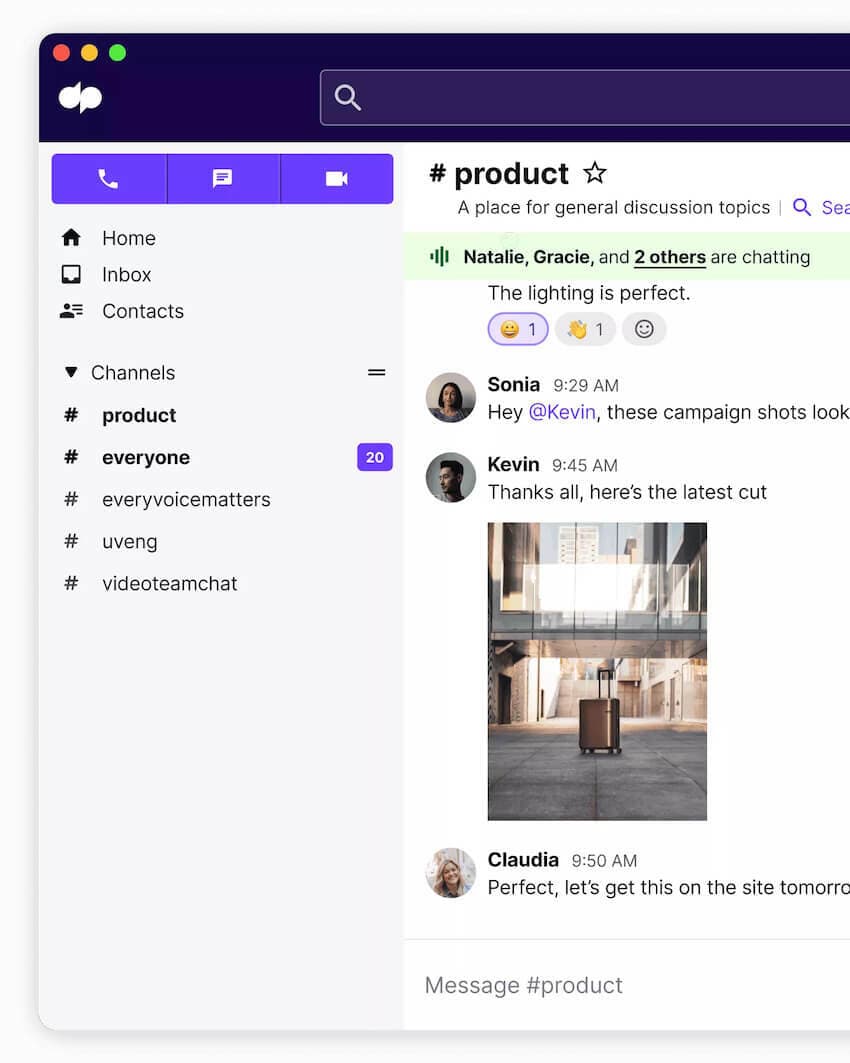
Empathetic
When unhappy customers come to you, the best thing your agents can realistically do is be empathetic and solve their problem as quickly as possible. Notice I said “and,” not “or.”
Solving a customer’s problem successfully is great, and most people will be perfectly content with that, but if you want to provide exceptional service, then empathy is a must-have.
Empathy is a really good customer service skill to have, because when you’re customer-facing, you never really know what the day’s calls and messages are going to throw at you.
Yes, scripts and templates can be helpful for reps, but they’re typically best used as a starting point, rather than straight copy-and-pasting. (You’d be surprised at how many customers can easily tell the difference between a canned response and one that’s not a template.)
Basically, the less your agents can rely on rigid scripts, the easier it’ll be for them to convey empathy when they’re talking to customers.
Proactive
A good customer service department is presented with a problem and does its best to resolve it. But exceptional customer service teams can anticipate its customers’ needs too.
People often ask me how this is possible. “Even if we could try to get ahead of customer expectations, that’s something that only big enterprises can do. How can you expect a small business to do the same thing?”
Well, with the right tools, I’d argue that it is possible—and not that hard to do either. For example, our Support team uses Dialpad Ai Contact Center to track how often certain problems or keywords come up on customer calls. I mentioned using RTA cards to pop up automated tips for agents, but Dialpad’s contact center platform can do more than that!
Say I’ve been hearing from my agents that we’ve been getting lots of questions on calls lately about Feature X, which we just launched. I can create a “Custom Moment” in Dialpad to track how frequently “Feature X” gets mentioned on calls, and monitor it from my analytics dashboard:
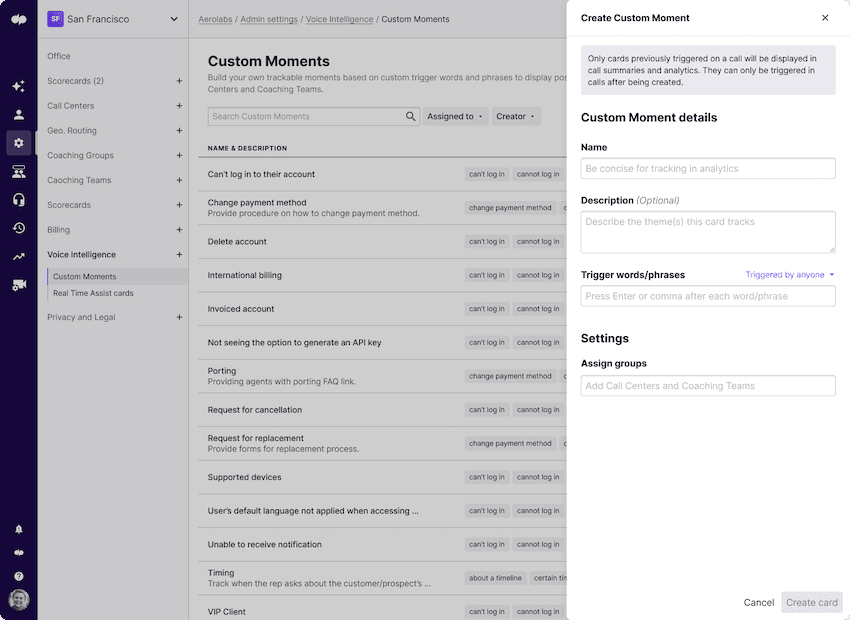
If I do notice any anomalies, then we can update our training materials or create new RTA cards.
Another great way to provide proactive service is to have self-service automations like a support chatbot and/or online knowledge base that your customers can use to find answers to time-sensitive issues 24/7.
With Dialpad, for instance, we can easily set up a self-service chatbot with just a few clicks using the drag-and-drop builder:

Chatbots are a great customer service tool because they’re relatively inexpensive and can run on your website at all hours of the day so that your customers aren’t completely stranded if your agents can only cover business hours in one time zone, for instance.
👉 A quick tip:
If you haven’t already, make sure your CRM is integrated with your contact center software. This will let your customer service representatives quickly see a customer’s profile and relationship history when they call. For example, Dialpad has CRM integrations with tools like Salesforce and HubSpot to automatically pull up this information for agents when they’re on calls.
3 key benefits of exceptional customer service
Good customer service doesn’t just brighten your customers’ day. It’s good for your bottom line too. Here are three key benefits for businesses that can consistently provide exceptional customer service.
1. Lasting customer relationships and loyalty
Every touchpoint on the customer journey contributes to the overall perception your customers have of your brand. That’s why bad customer service is so, well, bad. One severe misstep can ruin all the goodwill you’d earned from providing average or even good(!) customer service up until this point.
That’s why it’s important to provide exceptional customer service consistently. This will help you build trust and reinforce those customer relationships—after all, loyal customers are loyal not because businesses never mess up. (That’s not possible.) They’re loyal because for every one time that business messed up, they remember 10 really good interactions.
Think of it as building a buffer that’ll protect your customer relationships from mistakes in the future.
2. A stronger brand for your business
Today’s customers have many communication channels—and they aren’t afraid to share their experiences with family, friends, and anonymous internet users.
A quick search on social media should show you how willing customers are to criticize both you and your competitors when they’ve had a negative experience. But just as importantly, they will also take the time to share positive customer interactions and provide referrals—especially those that are truly amazing.
In fact, a study by the CFI group found that more than a third of customers are willing to share their customer service experiences, and half of those will share their views on social media:
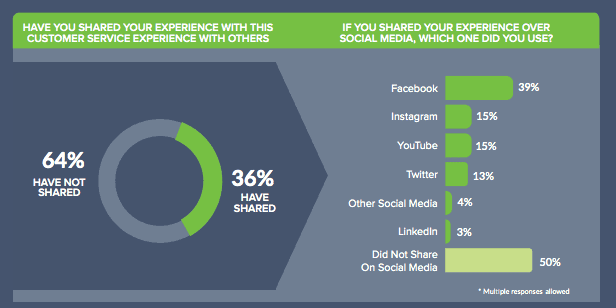
With a stronger brand, you’ll not only give your marketing efforts some tailwinds because prospects will know and trust you more off the bat, but also lower the costs of acquiring new customers overall.
(And of course, more loyal customers will have a much higher customer lifetime value or CLV on average.)
3. A competitive advantage
On a related note, exceptional customer service (or a lack of it) is becoming a major differentiating factor in how consumers choose companies to buy products and services from. How easy is it to reach customer support? How quickly can they solve your issues?
Being able to provide exceptional customer service does come at a cost. You need people, good customer engagement tools, executive support, and more. This is where you can set your business apart. For example, at Dialpad, we provide 24/7 tech support to our Pro and Enterprise plan customers—worldwide. We know that many of our competitors don’t do this, and that is often a differentiator when customers choose us over other competitors:
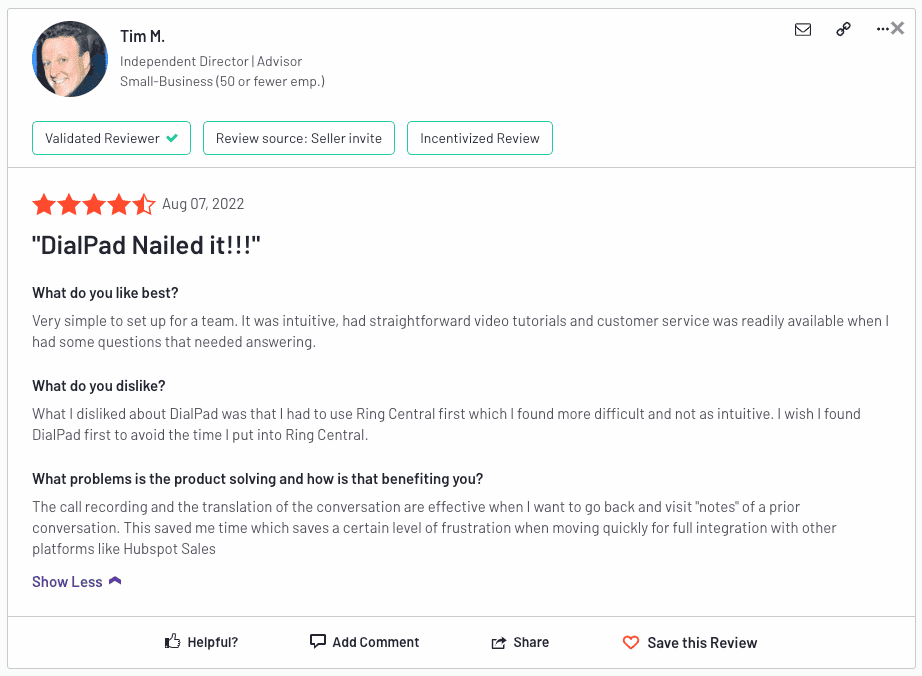
Remember, pricing isn’t the only way to win and keep customers. Even if your products are slightly more expensive, if you can offer great customer service, you can still win more customers and achieve better customer retention.
6 ways to deliver exceptional customer service
Providing the best customer service isn’t always easy, but here are a few customer service techniques that can help.
1. Make sure agents have a thorough understanding of your product or service
Stop me if this has never happened to you: You call up customer support for a new product that just isn’t working straight out of the box. You’re greeted by a friendly customer service agent and the conversation starts off great.
But, as you talk to the rep about your issue, you find yourself wondering how much this person actually knows about this product. That’s not uncommon at all, especially when companies have just onboarded new reps or released new features that their team isn’t familiar with yet.
It’s up to your contact center supervisors and managers to create and provide onboarding materials and a thorough knowledge base.
Friendliness and empathy aren’t enough to earn happy customers. They just have to be able to solve their problems efficiently.
2. Give your agents the tools they need
Every call or support ticket is different. Each customer will have their own experience and expectations. Your agents have to be quick on their feet and be able to adapt to what those customers need, how quickly they expect a resolution—and that’s not even considering how technically challenging the question is!
To help with response times, we have the RTA cards that pop up notes for agents, but our managers also use Dialpad’s live sentiment analysis feature to keep an eye on multiple calls at once. If a call is going south, we’ll see a little red indicator next to it, and can open up the real-time transcript (which gets populated as the call is happening) to get more context before deciding whether the agent needs us to intervene:

Even the best agents will need help sometimes. Make sure the contact center technology you’re using can get them that help quickly.
3. Provide personalized service where you can
Personalization goes a long way in acquiring new customers and strengthening customer loyalty. Whether it’s in the form of follow-ups to make sure that a problem has been resolved successfully or recommending products or services that fit with what your customers are looking for, there are a variety of ways you can provide personalized service and delight customers.
Here’s an exceptional customer service example: A Zappos agent sent a personalized note along with a product replacement—which made for a very happy customer:
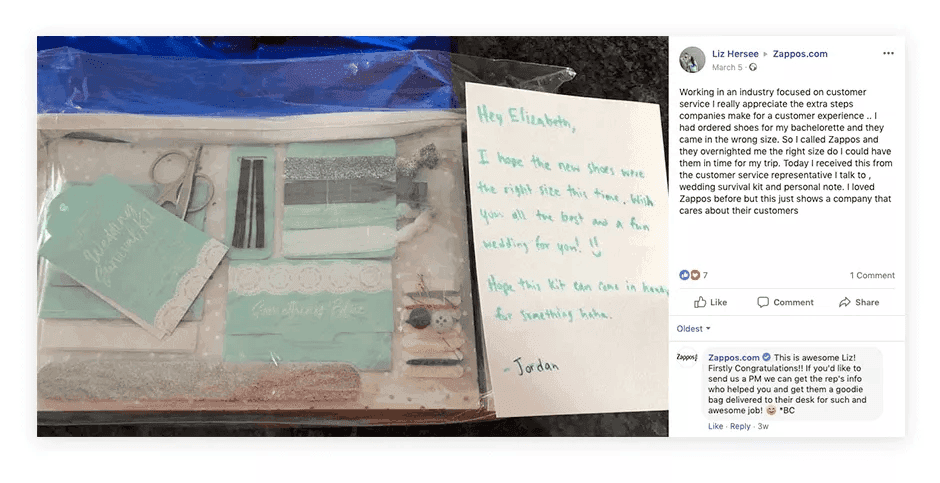
As I mentioned earlier, integrating your CRM with your agents’ virtual call center or contact center platform will really help with personalization, since it centralizes all your customers’ past histories with your company in one place. Even if a rep has never spoken with a customer before, they can still quickly pick up the threads of a past conversation and make the customer feel like your company remembers who they are and what they like—a truly exceptional feeling!

4. Offer helpful self-service content
Building a comprehensive knowledge base is the most effective way to give your customers the DIY resources they need, even when it’s outside business hours for your team.
When you’re pulling together these resources, go through your conversations and calls with customers. What questions get asked the most? Which features or products tend to create the most issues that lead to customers contacting you? These are all valuable insights that will help you build out your online knowledge base, deflect calls, and help customers self-service.
Of course, to do all this, you’ll need to have call recordings and transcripts so that you can actually dig through those conversations. Your cloud phone system or contact center platform should let you do this—we use Dialpad Ai Contact Center to record our calls (while staying compliant!) and get transcriptions afterward:
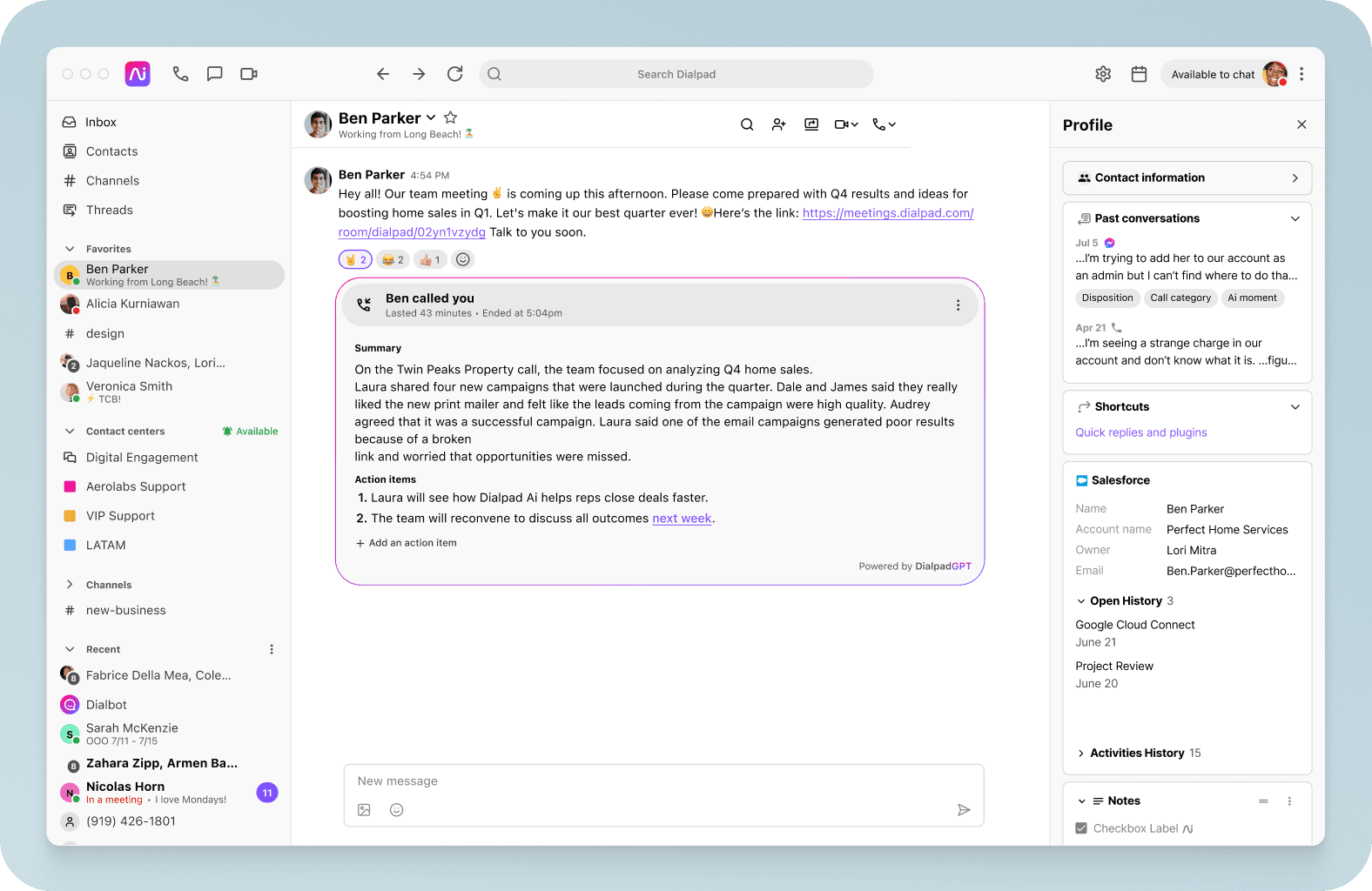
This gives us a treasure trove of qualitative data and direct feedback from our customers about what they tend to need help with—so we can help them self-service while also lightening the load for our agents.
👉Dialpad tip:
Knowledge bases aren’t just for your customers. Your agents will also have access to the same knowledge base to help streamline call handling and increase first call resolution.
5. Build a human-centric customer service experience
While many customers do enjoy self-service solutions as one way to try to solve problems on their own, they also prefer to be able to easily reach a human when they do have tricky problems or issues that are more complex.
So, why make it hard for them to reach a person? This is one of the biggest mistakes that I notice from companies. They have great self-service options like chatbots and knowledge bases—but there’s no easy way to escalate the issue to a video or voice call with a person if needed.
(This is why we designed Dialpad Ai Contact Center to make it easy to build a chatbot response flow—with an option to talk to a human agent. Chatbots are great, but they can’t really “go the extra mile” the way a human can.)
6. Review metrics regularly
Finally, don’t forget to review your metrics. Each business will measure a slightly different set of KPIs, but you should know your core metrics and how your team is performing against them.
For example, how are your CSAT (customer satisfaction) scores? We create CSAT surveys in Dialpad, which takes just a few minutes, and set them to trigger automatically after customer calls:

One of the biggest challenges with CSAT, though, is that not a lot of people actually fill out those surveys. In fact (depending on the industry and specific business of course), we've found that on average only about 5% of customers actually fill out CSAT surveys. Plus, usually only the angriest—and happiest—customers actually bother to respond to these surveys, which means your CSAT scores are likely to be very skewed and not representative of how your customers feel overall.
Dialpad's industry-first Ai CSAT feature is designed to solve exactly that. Not only can our Ai transcribe calls and analyze sentiment in real time, it can also infer CSAT scores for 100% of your customer calls thanks to its hyper-accurate transcription feature. The result? A much more representative sample size for CSAT scores, and a more accurate understanding of how satisfied your customers really are:

Besides this, Dialpad also has other built-in analytics in its dashboard as well, like heat maps that show call volume patterns and even our average speed to answer:

You need to be able to keep track of these types of numbers in order to see where your team can improve. (And provide exceptional customer service!)
Case studies: Businesses that provide exceptional customer service
CareRev
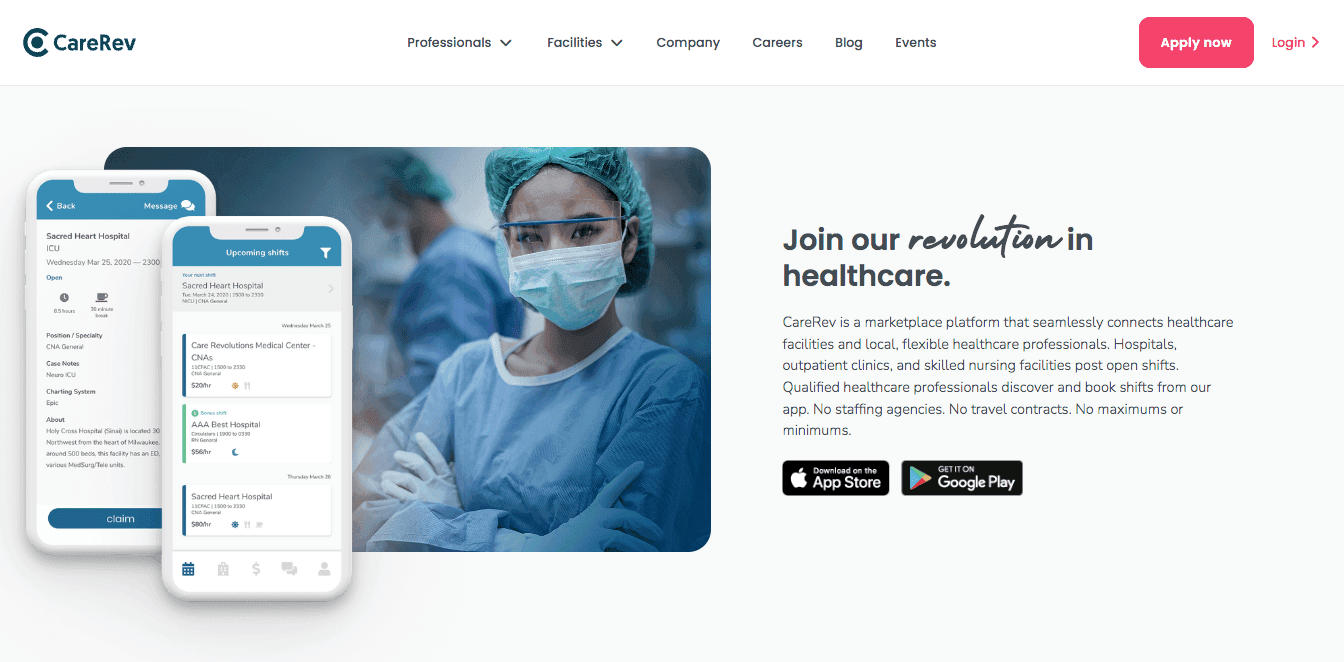
During pandemics, no one gets hit as hard as the healthcare industry. CareRev, which helps staff hospitals, had an issue that was impacting their important work: they were missing an average of 36 to 50% of their calls (almost half!) with their old phone system.
Missed calls were due to a combination of connection issues and devices not working, and it was seriously affecting their agents’ ability to provide a high level of service for healthcare professionals and hospitals that were using their platform.
It was a technology issue—and so they moved to a new communications platform that helped them reduce the number of missed calls by an incredible 90%!
Now, CareRev is able to provide fantastic customer service because they're not only getting better call quality, but also using Dialpad's helpful real-time AI features to help their supervisors.
Their Operations Manager, Dionne, said, “I can see how many agents are available and who's speaking on calls. And I love that I can see live calls in Dialpad, because I'm able to guide my team members in order to help them before an escalation is needed.”
Zappos
Zappos isn’t known for selling an earth-shattering amount of products, but the company achieved a massive level of success by providing truly excellent customer service. It got there by offering quick and low-cost shipping, its amazing support team (who famously don’t have to adhere to templates), and its generous return policy.
There’s no shortage of stories from happy customers who received their orders in time for important events like weddings (and funerals), who have received responses in lightning-fast response times, and who generally have just had awesome customer experiences with Zappos.
📚Further reading:
Zappos’ late CEO, Tony Hsieh, broke down his philosophy in detail with Harvard Business Review.
Rently
Rently provides property managers with self-touring and smart home technology and support. They had high customer service goals, but were being held back by their communications platform— inaccurate reporting and constant crashing were costing them not just money, but also customer satisfaction and happiness.
So, they switched to new contact center software that directs all their calls to the right department, gives them important insights that help their agents learn and improve, and more. “We’re handling 2 to 3,000 calls a week with Dialpad,” says Sahil, their Head of Customer Care.
With their new customer service platform, Rently is maintaining an impressive CSAT score over 4.5 too!
Features to look for in a platform to help you deliver exceptional customer service
From contact center AI to the basics like an easy-to-update call routing menu, there are a few fundamental features to look for when you’re shopping for a contact center or customer engagement platform. Here are a few of the key things I’d recommend looking for.
Real-time agent assists
Sometimes called “call pops,” it’s really important to have some type of real-time automation that gives your agent help when they’re chatting with a customer and tough questions come up. This type of functionality is usually powered by artificial intelligence, and is extremely useful not only during onboarding, but also as a form of ongoing training for your agents.
Live transcriptions
Another must-have for supervisors and managers. Being able to see real-time transcripts for the calls that your agents are on is essential if, like me, you’re overseeing multiple agents who are all on simultaneous calls.
What’s nice about Dialpad’s voice transcription feature is that it’s built right into the platform. We don’t have to go through a third-party vendor or integration to get those real-time transcripts.
Omnichannel communications
If your customers reach out to you through different communication channels, then you need to be able to meet them on those channels.
For example, we sometimes get questions and comments from customers and prospects through Facebook, LinkedIn, live chat, and more, which is why it’s helpful for us that Dialpad’s omnichannel contact center platform lets us handle messages across all those channels and consolidates those conversations in one place to make things easier for our agents:

Built-in analytics
You can’t improve your customer service if you don’t know what’s going on in your contact center. Look for a contact center platform that comes with built-in call analytics so that you can easily see things like missed and abandoned calls, call volume patterns, average handle time, and average speed to answer:

What’s also nice is that Dialpad has notifications that automatically alert us if our service levels drop below a certain threshold!
Want to provide exceptional customer service?
Delivering exceptional customer service comes down to both the people you hire and the tools you equip them with.
If you need a communications platform that empowers your team to serve a high volume of customers with a consistently high level of service, why not get a walkthrough of Dialpad Ai Contact Center?
Uplevel your customer service with a better contact center platform
See how Dialpad Support makes it easy for a distributed team of agents and supervisors to collaborate and keep your customers happy!








